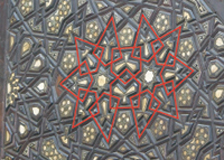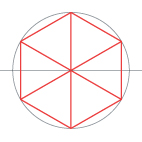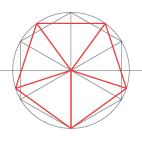In 1796 the most illustrious Carl Friedrich Gauss (then 19) proved that a 17-sided
polygon (often known as a heptadecagon, or sometimes the heptakaidecagon) was
constructible AND that 7, 11, 13 and 19-siders were not. Unfortunately, the Gaussagon
is not readily distinguished from a circle at small scales, for example if one wants to
have cufflinks made in that shape.
Meantimes, much closer to Alexandria, one of the hotbeds of geometry in antiquity,
Emir Qijmas al-Ishaq built a mosque in Cairo late in the 15th century (1479-1481, we
think) . One could probably spend a very long time touring just the mosques of Cairo -
and be the envy of geometers everywhere. In this particular instance, the emir's
architect had to solve a formidable problem just to fit the mosque on a triangular piece
of land at Darb al-Ahmar (apologies for the low quality image of the mosque below).
polygon (often known as a heptadecagon, or sometimes the heptakaidecagon) was
constructible AND that 7, 11, 13 and 19-siders were not. Unfortunately, the Gaussagon
is not readily distinguished from a circle at small scales, for example if one wants to
have cufflinks made in that shape.
Meantimes, much closer to Alexandria, one of the hotbeds of geometry in antiquity,
Emir Qijmas al-Ishaq built a mosque in Cairo late in the 15th century (1479-1481, we
think) . One could probably spend a very long time touring just the mosques of Cairo -
and be the envy of geometers everywhere. In this particular instance, the emir's
architect had to solve a formidable problem just to fit the mosque on a triangular piece
of land at Darb al-Ahmar (apologies for the low quality image of the mosque below).
Regardless of whether the surface was horizontal (a ceiling or a floor) or vertical (a wall or
equivalent), one of the preferred methods of covering the area was geometric tesselations. For
hundreds of years, thousands of mosques all over the world have used tiling patterns that feature
pentagons, hexagons and octagons. The Emir Qijmas al-Ishaq mosque showcases the very rare use
of a heptagon. If anyone has a picture of a heptagonal pattern please send it along. In the other
low-quality image below the red highlighted pattern contains two seven-pointed stars. We illustrate
the regular hexagon and pentagon below and to the right.
equivalent), one of the preferred methods of covering the area was geometric tesselations. For
hundreds of years, thousands of mosques all over the world have used tiling patterns that feature
pentagons, hexagons and octagons. The Emir Qijmas al-Ishaq mosque showcases the very rare use
of a heptagon. If anyone has a picture of a heptagonal pattern please send it along. In the other
low-quality image below the red highlighted pattern contains two seven-pointed stars. We illustrate
the regular hexagon and pentagon below and to the right.



